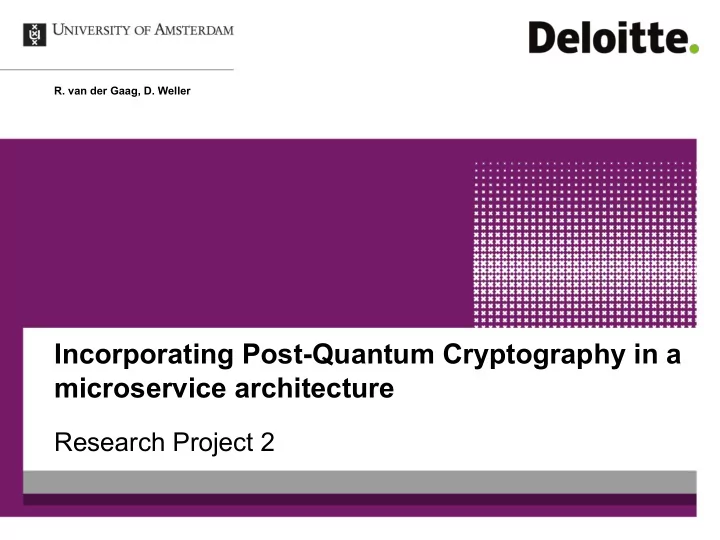

R. van der Gaag, D. Weller Incorporating Post-Quantum Cryptography in a microservice architecture Research Project 2
Why think about post-quantum cryptography W. Buchanan et. al concluded ● Gate-based quantum computers pose a significant threat to a-symmetrical encryption (which is used in PKI) ○ Shor’s algorithm ● Likely theoretical → practical <10 years A-symmetric keys are used by: ● (D)TLS ● SSH ● WPA & WPA2 ● DNSSec ● IKEv2 (IPSec & VPN) ● S/MIME Incorporating post-quantum cryptography in 2 a microservice architecture
Research questions What are the implications of transitioning to post-quantum cryptography in many-to-one microservice architectures where certificates are used for both encryption and mutual authentication ? Two sub questions: 1. Suitable algorithms 2. Practical feasibility Incorporating post-quantum cryptography in 3 3 a microservice architecture
Related work National Institute of Standards and Technology (NIST) ● 2nd round with Post Quantum Cryptography (PQC) ○ 17 different Post Quantum Key Exchange Algorithms ○ 9 different Post Quantum Signature Algorithms E. Crockett et. al - OpenQuantum Safe ● Forked OpenSSH ● Forked OpenSSL ○ 8 different Post Quantum Key Exchange Algorithms ○ 3 different Post Quantum Signature Algorithms Incorporating post-quantum cryptography in 4 a microservice architecture
Related work (cont) J. Kreps et. al - detailed insight about inner workings of Kafka K. Sheykh Esmaili et. al - important aspects of microservices: ● Correctness - Delivery guarantees & Ordering guarantees ● Availability - Maximize its uptime ● Transactions - Group messages into units ● Scalability - Evolve with growing amount of tasks ● Efficiency ○ Latency of a packet / message ○ Throughput (number / bytes of packets per time unit) Incorporating post-quantum cryptography in 5 a microservice architecture
Background What is Kafka? - - Publish / subscribe mechanism Developed by LinkedIn - - Stands out in bulk messaging - Passive and stateless - Publisher (delivers data) pushes data Consumer (requests data) pulles data - - What is Post Quantum Cryptography? Classical key exchange relies on factorization (e.g. RSA) or - logarithmic (e.g. DH and ECC) mathematical problems - PQC relies on other mathematical problems - Not yet solvable by quantum computers Incorporating post-quantum cryptography in 6 a microservice architecture
Open Quantum Safe OpenSSL fork Level Post Quantum Key Exchange Post Quantum Digital Signature Mechanisms Algorithms I bike1l1cpa, bike1l1fo, frodo640aes, dilithium2 frodo640shake, Kyber512, picnicl1fs newhope512cca, ntru_hps2048509, qteslapi lightsaber, sidhp434, sikep434 II Sidhp503, sikep503 dilithium3 III Bike1l3cpa, bike1l3fo, frodo976aes, dilithium4 frodo976shake, ntru_hps2048677, qteslapiii ntru_hrss701, Saber, Sidhp610, sikep610 IV None None V frodo1344aes, frodo1344shake, None kyber1024, newhope1024cca, Ntru_hps4096821, Firesaber, Sidhp751, sikep751 Incorporating post-quantum cryptography in 7 a microservice architecture
Open Quantum Safe OpenSSL fork Hybrid Algorithms Level Hybrid Post Quantum Key Exchange Hybrid Post Quantum Digital Signature Mechanisms Algorithms I p256_bike1l1cpa, p256_bike1l1fo, rsa3072_dilithium2, p256_dilithium2, p256_frodo640aes, p256_frodo640shake, rsa3072_picnicl1fs, p256_picnicl1fs, p256_kyber512, p256_newhope512cca, rsa3072_qteslapi, p256_qteslapi p256_ntru_hps2048509, p256_lightsaber, p256_sidhp434, p256_sikep434. II None None III None p384_dilithium4, p384_qteslapiii IV None None V None None Incorporating post-quantum cryptography in 8 a microservice architecture
Methodology: What are the handshake differences (elapsed time, peak heap - memory) between - Classical cryptography - Post-Quantum Cryptography Hybrid-Post-Quantum Cryptography - - Divide the algorithms per security level (provided by NIST) Level Security Description I At least as hard to break as AES128 (exhaustive key search) II At least as hard to break as SHA256 (collision search) III At least as hard to break as AES192 (exhaustive key search) IV At least as hard to break as SHA384 (collision search) V At least as hard to break as AES256 (exhaustive key search) Incorporating post-quantum cryptography in (NIST, 2019) 9 a microservice architecture
Results Classical Cryptography algorithms Incorporating post-quantum cryptography in 10 a microservice architecture
Results Handshake Level 1 - PQC Incorporating post-quantum cryptography in 11 a microservice architecture
Results Handshake Level 1 - Hybrid PQC Incorporating post-quantum cryptography in 12 a microservice architecture
Results Handshake Level 2 - PQC Incorporating post-quantum cryptography in 13 a microservice architecture
Results Handshake Level 3 - PQC Incorporating post-quantum cryptography in 14 a microservice architecture
Preliminary conclusions What are the implications of transitioning to post-quantum cryptography in many-to-one microservice architectures where certificates are used for both encryption and mutual authentication ? ● Suitable algorithms ○ L1 ■ Dilithium2 - Kyber512 / Lightsaber / NewHope512cca ■ Picnicl1fs - Kyber512 / Lightsaber / NewHope512cca ■ qTeslapi - Kyber512 / Lightsaber / NewHope512cca ○ L2 ■ Dilithium3 - SiDHp503 ○ L3 ■ Dilithium4 - Saber / Frodo / NTRU ■ qTeslapiii - Saber / Frodo / NTRU Incorporating post-quantum cryptography in 15 a microservice architecture
Preliminary conclusions (cont) What are the implications of transitioning to post-quantum cryptography in many-to-one microservice architectures where certificates are used for both encryption and mutual authentication ? ● Practical feasibility ○ Kafka relies on Java ■ PQC not yet implemented in Java Security stack ■ Using the OpenSSL fork for Kafka requires additional customization ○ Using the OpenSSL fork ■ Using Hybrid for transitioning ■ Handshake time is not that much longer Incorporating post-quantum cryptography in 16 a microservice architecture
Discussion - Algorithms still in development - NIST Round 2 still in progress - We did not test these algorithms in a microserver environment - CPU measurements not taken into account - Our setup was optimal, we did not test multiple concurrent sessions Incorporating post-quantum cryptography in 17 a microservice architecture
Future work - Experiment with Java Security stack - development of general interface for third party libraries - Experiment with liboqs algorithms in the OpenSSL fork - Still in development - Not all are available for proper testing Incorporating post-quantum cryptography in 18 a microservice architecture
Recommend
More recommend